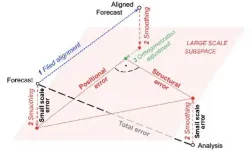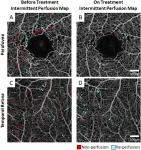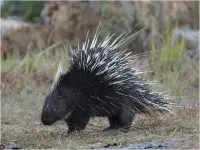Analysis of autopsy, toxicological and psychiatric reports of Portugal's first major forensic case
Part III
2021-05-10
(Press-News.org) Analysis of The Autopsy, Toxicological, and Psychiatric Reports of Portugal's First Major Forensic Case: Part III
https://doi.org/10.1080/20961790.2021.1898079
Announcing a new article publication for Forensic Sciences Research journal. In this review article the author Ricardo Jorge Dinis-Oliveira of the University Institute of Health Sciences (IUCS)-CESPU, Gandra, Portugal continues a three-part investigation of the "Crime of Flores Street" one of the most famous cases of poisoning which occurred in Portugal in the late 19th century. The case demonstrated the weaknesses of the Portuguese medicolegal system and attests to the importance of toxicological analysis. The first article retold the case which gave birth to forensic toxicology studies in Portugal and informed present day Portuguese medicolegal procedures. The second article analysed all the relevant and contradictory testimonial evidence of the prosecution and defence witnesses.
In this latest publication the author analyses the forensic evidence, particularly from the autopsy, toxicological, and psychiatric forensic reports. Today, it would be easy to perform irrefutable toxicological analysis, but in those times, the circumstantially produced evidence, together with the toxicological expert reports, allowed the court to produce a damning judgment. The author suggests, that with current knowledge, it is now possible to add further insights if the burial location of at least one victim could be identified. In late 2020 one of the victims was finally located. Permission for a new autopsy for samples collection was obtained and has been performed more than 130 years after the first major autopsy was executed in Portugal. Future research will include correlation of the identity of the victim by DNA analysis and comparison with relatives and toxicological analyses.
INFORMATION:
Related Publications
Ricardo Jorge Dinis-Oliveira, Portugal's first major forensic case and the genesis of forensic toxicology: 10 years of research to reconstruct the event, Forensic Sciences Research, 2018, ISSN 2471-1411, https://doi.org/10.1080/20961790.2018.1534538
Ricardo Jorge Dinis-Oliveira, Analysis of the testimonial evidence of Portugal's first major forensic case: part II, Forensic Sciences Research, 2019, ISSN 2471-1411, https://doi.org/10.1080/20961790.2019.1682218
Author Biography
Ricardo Jorge Dinis-Oliveira University Institute of Health Sciences (IUCS)-CESPU, and Faculty of Medicine of University of Porto, Portugal. Degree in Pharmaceutical Sciences, 2003, doctorate in Toxicology, 2007, Faculty of Pharmacy, University of Porto, Portugal. Member of Pedagogical, Scientific and Management Councils of the IUCS, member of the Installing Committee of the accreditation process of the Integrated Master in Medicine of IUCS and member of the Monitoring Committee of the 2nd and 3rd Cycles of Studies in Forensic Sciences of the University of Porto. Research interests include Toxicology and Forensic Medicine, namely in additive behaviors, fatal intoxications of pharmacological origin and others and driving under the influence of psychoactive substances. Member of Editorial Boards of several International Scientific Journals in the area of Health and Life Sciences. Author of more than 155 journal articles, 35 book chapters, 4 books and 4 national and 3 international patents. Founder and current President of the Portuguese Association of Forensic Sciences (APCF) and former Vice President of the Portuguese Society for the Study of Abuse and Neglect (SPEAN).
Article reference: Ricardo Jorge Dinis-Oliveira, Analysis of the autopsy, toxicological, and psychiatric reports of Portugal's first major forensic case: part III, Forensic Sciences Research, 2021, ISSN 2471-1411, https://doi.org/10.1080/20961790.2021.1898079
Keywords: Forensic reports; alkaloids; history of legal medicine; Flores Street; Vicente Urbino de Freitas; José António de Sampaio Junior; Mário Guilherme Augusto de Sampaio
The Journal of the Academy of Forensic Science (AFS), Shanghai, P.R. China.
Forensic Sciences Research is a quarterly peer reviewed open access, English language journal publishing international research on forensic sciences, including forensic pathology, clinical forensic medicine, criminalistics and crime scene investigation. It aims to promote forensic sciences through quality research articles, reviews, case reports, and letters to editors.
For more information, please visit https://www.tandfonline.com/toc/tfsr20/current
Editorial Board: https://www.tandfonline.com/action/journalInformation?show=editorialBoard&journalCode=tfsr20
Forensic Sciences Research is available on Taylor & Francis Online (https://www.tandfonline.com/action/showAxaArticles?journalCode=tfsr20 ).
Submissions to Forensic Sciences Research may be made using Editorial Manager® (https://www.editorialmanager.com/tfsr/default.aspx ).
Usage
187K annual downloads/views
Citation metrics
1.2 (2019) CiteScore
1.22 (2019) SNIP
0.487 (2019) SJR
Speed/acceptance
21 days avg. from submission to first decision
52 days avg. from submission to first post-review decision
53 days avg. from acceptance to online publication
31% acceptance rate
Print ISSN: 2096-1790
Online ISSN: 2471-1411 END
[Attachments] See images for this press release:

ELSE PRESS RELEASES FROM THIS DATE:
2021-05-10
Most people who are infected with SARS-CoV-2 develop no or only mild symptoms. However, some patients suffer severe life-threatening cases of COVID-19 and require intensive medical care and a ventilator to help them breathe. Many of these patients eventually succumb to the disease or suffer significant long-term health consequences. To identify and treat these patients at an early stage, a kind of "measuring stick" is needed - predictive biomarkers that can recognize those who are at risk of developing severe COVID-19.
First biomarker to predict severity of disease
A team led by Professor Burkhard Becher at the Institute of Experimental Immunology at the University of Zurich, working with researchers from Tübingen, Toulouse and Nantes, has now discovered such ...
2021-05-10
Due to the chaotic nature of the atmosphere, weather forecasts, even with ever improving numerical weather prediction models, eventually lose all skill. Meteorologists have a strong desire to better understand this process as they try to trace forecast error back to observational gaps and to provide a means for improvement.
Root mean square error (rms, or its square, the variance distance) is often used to measure differences between simulated and observed fields. In this case, scientists measured the distance between a model forecast field within its grid and the verifying analysis field ...
2021-05-10
A pioneering study by UCL scientists has discovered the presence of a harmful inflammatory protein in patients with symptomatic tuberculosis (TB).
Researchers say, by targeting the IL-17 cytokine, a component produced naturally by the immune system in response to infection, excessive and damaging lung inflammation caused by TB may be significantly reduced to help speed up patient recovery.
TB is an infection caused by the bacterium Mycobacterium tuberculosis and is the leading cause of death from infections worldwide. The World Health Organisation estimates that 1.4 million people died of TB disease worldwide in 2019.
Explaining the experimental study, lead author Dr Gabriele Pollara (UCL Division of Infection & Immunity), ...
2021-05-10
In a time of a global crisis such as the ongoing COVID-19 pandemic, it is easy to note how people move through different phases to buckle up for such unprecedented and arduous times.
In the very beginning of the pandemic last year, we observed "an epidemic of fear", where it was all about the calamitous nature of a totally unknown virus and its worrying contagiousness and mortality rate. A few months later, with lockdown and restrictions already in place across the world, the fear was replaced by "an epidemic of explanations", where people even in their naivety, started to seek a sense of comfort by ...
2021-05-10
Climate change, a pandemic or the coordinated activity of neurons in the brain: In all of these examples, a transition takes place at a certain point from the base state to a new state. Researchers at the Technical University of Munich (TUM) have discovered a universal mathematical structure at these so-called tipping points. It creates the basis for a better understanding of the behavior of networked systems.
It is an essential question for scientists in every field: How can we predict and influence changes in a networked system? "In biology, one example is the modelling of coordinated neuron activity," says Christian Kühn, professor of multiscale and stochastic dynamics ...
2021-05-10
Can expert commissions develop solutions for controversial issues that will enjoy broad democratic support? A team of researchers from the Institute for Advanced Sustainability Studies (IASS) has analysed the work of Germany's "Coal Exit Commission" using a set of new criteria. While the authors view positively the Commission's success in reaching a compromise, they criticise its failure to deliver an outcome that promotes the common good, particularly with respect to the high cost of the coal exit and its unambitious contribution towards Germany's climate goals, as well as the lack of public participation.
On 29 April 2021, Germany's Federal Constitutional Court ruled that the provisions of the Climate Protection Act (2019) are incompatible ...
2021-05-10
Only one in three fertilizations leads to a successful pregnancy. Many embryos fail to progress beyond early development. Cell biologists at the Max Planck Institute (MPI) for Biophysical Chemistry in Göttingen (Germany), together with researchers at the Institute of Farm Animal Genetics in Mariensee and other international colleagues, have now developed a new model system for studying early embryonic development. With the help of this system, they discovered that errors often occur when the genetic material from each parent combines immediately after fertilization. This is due to a remarkably inefficient process.
Human somatic cells typically have 46 chromosomes, which together carry ...
2021-05-10
Ophthalmologists at New York Eye and Ear Infirmary of Mount Sinai have created a new technique to evaluate patients with sickle cell retinopathy and assess the disease before it progresses and leads to permanent vision loss.
Using optical coherence tomography (OCT) angiography--an advanced imaging system that captures the motion of red blood cells in blood vessels non-invasively--the researchers discovered that sequential imaging of affected retinal blood flow in sickle cell patients can help assess how the disease is progressing and how effective their treatment is for reducing focal vascular strokes. Their study was published ...
2021-05-10
Porcupines are frequently traded across Asia, and Indonesia, home to five species, is no exception. They are targeted for a number of reasons: their meat as an alternative source of protein, their bezoars consumed as traditional medicine, and their quills used as talismans and for decorative purposes.
A new study examining seizure data of porcupines, their parts and derivatives in Indonesia found a total of 39 incidents from January 2013 to June 2020 involving an estimated 452 porcupines. The research was published in the open-access, peer-reviewed journal Nature Conservation.
There are no harvest quotas for any porcupine species in Indonesia, which makes all hunting and trade in porcupines illegal. Of the five species found in the country, only the Sunda porcupine (Hystrix javanica) ...
2021-05-10
COLUMBUS, Ohio - The symptoms of grief people feel for a loved one facing a life-limiting illness fluctuate over time, a new study found - suggesting that individuals can adjust to their emotional pain, but also revealing factors that can make pre-loss grief more severe.
Researchers examined changes in the severity of pre-loss grief symptoms in people whose family members had either advanced cancer or dementia.
The study is the first to document pre-loss grief at two points in time, and found that about 70% of participants' symptoms decreased over a month. However, compared to initial symptoms reported by participants, ...
LAST 30 PRESS RELEASES:
[Press-News.org] Analysis of autopsy, toxicological and psychiatric reports of Portugal's first major forensic case
Part III




